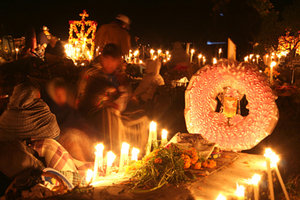





Of all the flowers to come from the Aztec world, this one is by far the most planted and cared for today. Once used in the major ceremonies to honor those departed, this flower now can be found in front of homes all over the world. Now you too can know the secrets of the cempas?chil, the marigold.
(Editor's Note: This article was originally published on November 30, 2007. Your comments are welcome, but please be aware that authors of previously published articles may not be able to promptly respond to new questions or comments.)
What makes a flower that is the symbol of death work its way into one of the world's most famous annuals? Let’s take a look at the history of the marigold and how it was used then and now.
Since prehispanic times, this plant has had medicinal purposes and it is thought to cure stomach ache, parasites, diarrhea, liver illnesses, vomiting, and toothache among other illnesses. The flowers are still used in many areas to cure these and other ailments. All of these illnesses are said to be cured by a tea made from the flowers, eating the flowers, or wearing the flowers in a pouch around the neck.
Every year on November first and second, the Aztecs relive a little of their past with the Dia De los Muertos, or Day of the Dead. Huge altars are set up with food and drinks are given to the deceased members of the household. No altar is ever complete without the gathering of the wild marigolds and the spreading of them everywhere from the family altar, to pathways, and even in the graveyards. This can be traced, in part, to the ancient Aztec celebration of Death.

In the last 2000 or so years these celebrations have changed little in the Aztec world. There is some thought that they started in the Totonacian area, now in Vera Cruz. What is known for sure is that the celebrations are ancient and highly revered in many areas of Latin America today. The ancient celebrations honored Mictecacihuatl, the goddess of the dead and death. The Aztecs believed that the smell could wake the souls of the dead to bring them back for the festival. The Spanish worked hard to get rid of the festival and for a long time the flowers themselves where not liked or loved.
Often in Mexico today the family will visit the cemetery where their loved ones are buried and bring them offerings. The main offerings given across the board, rich or poor, are the marigolds, or Flor del Muerto – Flower of the Dead. The flowers are thought to bring out the dead souls to feast on the offerings laid on the table or headstone.
The marigold came with Spanish traders to Africa and Europe. Wanting to disconnect it from the flower’s past, the breeding programs held in Africa and Europe gave this great flower the name of “African” and “French” marigold. After the flower was disconnected from its past reputation as the flower of death, it was introduced into the gardens of the world.
Today the flowers are prized by gardeners the world over for their long lived blooms that love the heat of summer. They are to be found in gardens across the world, a testament to the wonder of this wonderful flower of the dead.
Copyright © www.100flowers.win Botanic Garden All Rights Reserved